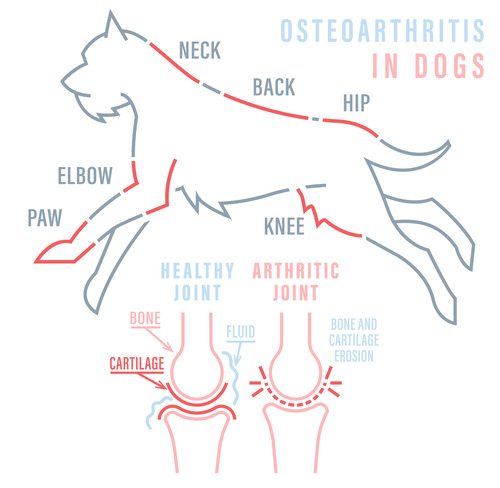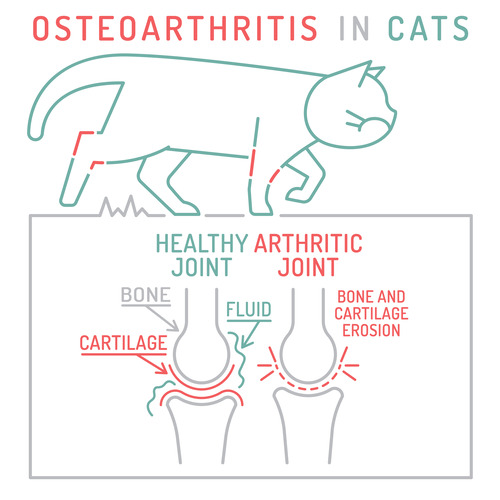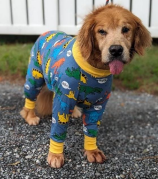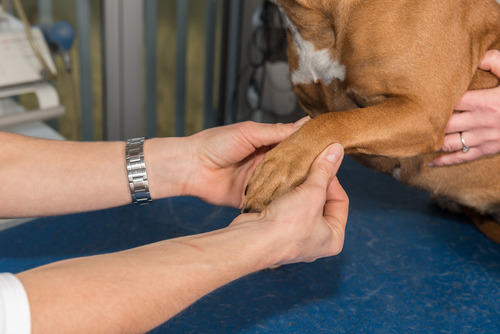Did you know that up to 80% of dogs over 8 years old1, and 90% of cats over 12 years old2 will experience pain from osteoarthritis? Osteoarthritis, or Degenerative Joint Disease (DJD), is irreversible. Our Pets may not be able to tell us they are painful with words; but they do have ways of showing us. Dogs might be a little stiff when getting up or laying down, hesitating or even refusing to go up or down the steps, limping at times, or even just not wanting to go as far on their walks. Cats are more difficult to assess, but you might notice they aren’t grooming themselves as well, having accidents outside of the litterbox, or not jumping up or down as much as they used to. We sometimes think that they are “just getting older and slowing down”, but age is not a disease – it’s the diseases that come with age! If we can treat, or even just slow down the progression of these diseases, then our pets can live a more pain free life (even when they have some gray around their muzzle). Luckily, there are multiple pain-control methods we can utilize to help improve their overall quality of life!


Librela is a once-a-month injection used in dogs with osteoarthritis3. This medication is a ‘Monoclonal Antibody’ Therapy, which means it is formulated with proteins that bind to pain receptors. This interrupts the signal to the brain that indicates there is injured tissue and pain in the joint. Since the signal is less likely to get to the brain, it is less likely to create an inflammatory response. Less inflammation = Less pain! Librela is broken down naturally like other proteins in the body, which means it has minimal involvement of the liver or kidneys. We have recently started carrying Librela at Veterinary Medical Center and have seen patients have really great results! Some clients even say they are acting like a puppy again!
Solensia is also a once-a-month injection used in cats with osteoarthritis4. This medication works the same way that Librela does but is made specifically for cats. It has been shown to be very well tolerated and has minimal effect on the liver and kidneys, even in cats with stage 1-2 kidney disease. Solensia is one of the few FDA approved long-term pain medications that can be used in cats.

My personal cat, Artemis (otherwise known as Arte-never-miss-a-meal) has been getting Solensia for a few months now and has done amazing! I’ve been in Veterinary Medicine for 6.5 years, and never realized how uncomfortable my own cat was, until he wasn’t. He went from walking slow and steady to running down the hallway! It also is a great alternative to giving oral medication every day (because cats are way too smart and will find the smallest pill in their food, and promptly spit it out when you’re not looking).
Adequan is an injection to help address underlying cartilage deterioration in dogs by reducing inflammation and helping to renew and rebuild synovial joint cartilage5. Adequan works best when started early, and when there is still some cartilage left to save. It is also recommended to be used as part of a multimodal approach. Adequan injections are given twice a week for 4 weeks, then about once every 2-4 weeks as needed or recommended by your veterinarian.


A Therapeutic Laser is more of a conservative approach to pain control. Rather than medications that are typically metabolized by the liver and kidneys, a therapeutic laser uses light wavelengths to stimulate and promote growth and repair of cells and tissue6. You may have seen lasers that you can buy online that seem similar, but veterinary offices will use professional-grade lasers that have higher wavelengths that are able to penetrate deeper and have a much stronger and longer lasting effect. This therapy can be used in multiple situations; such as on surgical incisions, wounds, tendon/ligament injuries or for arthritis. The only situation that it isn’t utilized for would be for a mass, as we don’t want to promote growth of abnormal cells.
Did you know that the word ‘LASER’ is actually an acronym? It stands for ‘light amplification of stimulated emission of radiation’ – the more you know!
If you think your pet might be showing signs of pain or discomfort, then call us to schedule an appointment! Your veterinarian will perform a physical exam and will likely be able to tell if your pet has any discomfort, although sometimes further diagnostics may be necessary to correctly diagnose.


- https://caninearthritis.co.uk/what-is-arthritis/arthritis-the-basics/#:~:text=Osteoarthritis%20(OA)%20is%20the%20most,of%20dogs%20of%20all%20ages ↩︎
- https://www.zoetisus.com/conditions/petcare/oa-pain/feline-oapain#:~:text=Nearly%2040%25%20of%20all%20cats,less%20frequently%20than%20in%20dogs. ↩︎
- https://www.zoetisus.com/products/dogs/librela/ ↩︎
- https://www.zoetisus.com/products/cats/solensia ↩︎
- https://adequancanine.com/for-veterinarians ↩︎
- https://www.aaha.org/your-peat/pet-owner-education/ask-aaha/laser-therapy/ ↩︎





